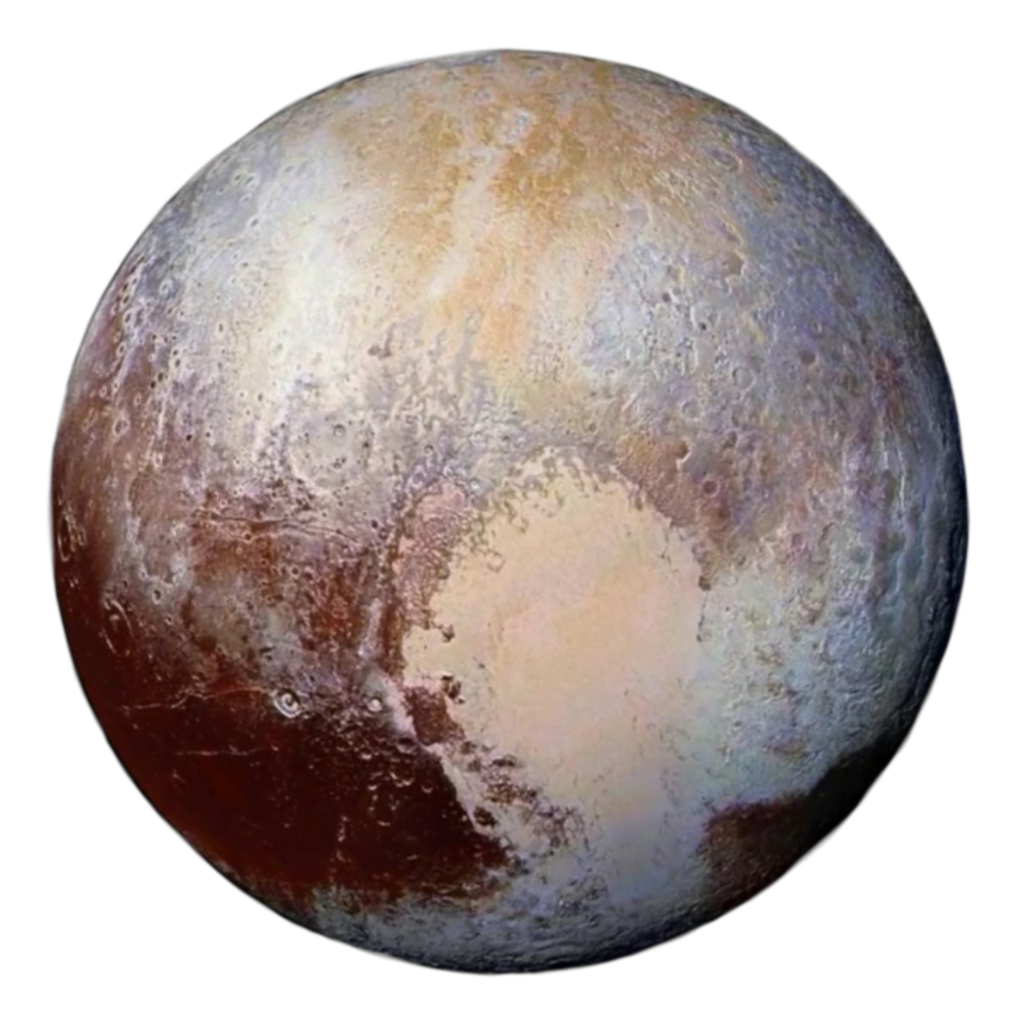Table of Contents
INTRODUCTION TO PLUTO
Pluto is a dwarf planet located in the Kuiper belt, which extends beyond Neptune‘s orbit. It is the ninth-largest and tenth-massive known object in direct orbit around the Sun. Pluto was reclassified as a dwarf planet in 2006, a move that sparked controversy and disagreement in both the scientific community and the general public. Pluto has five known moons: Charon, the largest, whose diameter is little more than half that of Pluto, followed by Styx, Nix, Kerberos, and Hydra.

FEATURES OF THE DWARF PLANET
Pluto Facts
- Equator circumference: 7,445 km
- Radius: 1,188 km
- Average distance from Sun: 5.9 billion km/ 39 astronomical units (AU)
- Surface temperature: -225°C
- Surface gravity: 0.62 m/s2 or 0.0632 g0
- Surface area: 1.774 X 107 Km2
- Volume: 7.057 X 109 Km3
- Mass: 1.3025 X 1022 Kg
- Escape Velocity: 1.212 m/s
- Mean density: 1.853 g/cm3
- Day length: 153 Hours
- Year length: 248 Earth years
- Sunlight travel time: 5.5 hours
- Average orbital speed: 10,623 mph (4.74 km/s)
- Moons: 5
- Planet type: Jovian
- Composition: Nitrogen, Methane, Carbon monoxide
HISTORY OF DISCOVERY
Percival Lowell, an American astronomer, first proposed the existence of Pluto in 1905 after observing odd deviations in the orbits of Neptune and Uranus. Lowell concluded that there must be another whose gravity is dragging on these ice giants, creating differences in their orbits. Lowell predicted the location of the mystery planet in 1915, but died 15 years before it was discovered. Pluto was found in 1930 by Clyde Tombaugh at the Lowell Observatory, after predictions by Lowell and other astronomers. After that it was named by 11-year-old Venetia Burney of Oxford, England.
ATMOSPHERE OF PLUTO
Pluto, previously considered the ninth planet but now categorised as a dwarf planet, has a thin and tenuous atmosphere that is remarkably complicated. Pluto’s atmosphere is mostly composed of nitrogen, with traces of methane and carbon monoxide, and is highly changeable due to its vast distance from the Sun and elliptical orbit. As Pluto approaches the Sun in its 248-year orbit, its surface ice, chiefly nitrogen, sublimates into gas, temporarily thickening the atmosphere. As Pluto travels away from the Sun, the atmosphere freezes and falls back to the surface as snow, causing significant fluctuations in atmospheric density.
Despite its thinness, Pluto’s atmosphere is stratified, with haze reaching 1,000 kilometres (620 miles) above the surface. This haze is made up of microscopic particles, most likely complex hydrocarbons called tholins, that arise when methane and other gases are broken down by ultraviolet sunshine. These tholins give Pluto’s atmosphere a bluish tint and contribute to its reddish-brown surface colouration. The haze layers are considered to occur as a result of temperature inversions in the atmosphere, in which some layers are warmer than others, leading particles to accumulate at specific altitudes.
Pluto’s atmosphere is likewise extraordinarily cold, with temperatures of roughly -375°F (-225°C), lower than any other planet’s atmosphere in the solar system. This chilly temperature is caused by the distance from the Sun and the lack of an adequate internal heat source. The thin atmosphere has a surface pressure of only approximately 10 microbars, or roughly one-millionth of Earth’s atmospheric pressure.
One of the most exciting characteristics of Pluto’s atmosphere is the prospect of seasonal changes, even if these changes take decades or centuries. In 2015, the New Horizons spacecraft saw Pluto’s atmosphere in unprecedented detail, showing an unexpectedly active and complex structure and raising doubts about the distant world’s long-term development. Despite its distance and small size, Pluto’s atmosphere remains a source of fascination for astronomers, providing insights into the mechanisms that build atmospheres on small, ice worlds in the outer solar system.

PLUTO'S STATUS AS A PLANET
Pluto had long been considered our 9th planet, but in 2006, the International Astronomical Union (IAU) changed its classification of Pluto to dwarf planet. Pluto did not fit into the definition of “planet” given by the IAU. To maintain its planetary status with Earth, Saturn, and the others, it had to pass three tests:
- It’s in orbit around the sun.
- It has enough mass to achieve hydrostatic equilibrium (a near-round form).
- It “cleared the neighbourhood” surrounding its orbit.
Pluto passes the first two conditions but does not clear its orbit. Pluto orbits alongside other objects in the Kuiper Belt, a region of the Solar System beyond Neptune populated by several tiny icy bodies. Pluto was classed as a dwarf planet since it no longer dominates its orbit. This reclassification was controversial and is still being discussed by some scientists and the general public, but it is the current official classification.

ORBIT OF PLUTO
Pluto’s distance from the Sun, with an extreme eccentricity of 0.2488, varies from 4,436,820,000 km at perihelion to 7,375,930,000 km at aphelion. Meanwhile, the average distance (semi-major axis) from the Sun is 5,906,380,000 kilometres. Another way to look at it is that it orbits the Sun at an average distance of 39.48 AU, with a range of 29.658 to 49.305 AU.
Pluto’s orbital period is approximately 248 years. Its orbital properties differ significantly from those of the planets, which have nearly circular orbits around the Sun near a flat reference plane known as the ecliptic. Pluto’s orbit is considerably inclined to the ecliptic (more than 17°) and eccentric (elliptical). This eccentricity means that a minor portion of Pluto’s orbit is closer to the Sun than Neptune‘s.
EXPLORATION OF PLUTO
The first and, so far, only mission to Pluto was NASA’s New Horizon. The mission, which was also the first to examine a recently found “third zone” in the Solar System beyond its large planets known as Kuiper Belts, has been completed.
The first mission to explore the third zone of our solar system, the dark, cold Kuiper belt, is the New Horizon mission. New Horizon was launched on 19 January 2006 and flew past Jupiter a year later. The start of Pluto’s approach has taken another 7 years. Pluto was a surprisingly diverse world, with craters, crevasses, glaciers, and a frozen heart of nitrogen ice, when New Horizons flew past Pluto in July 2015.
Pluto’s orbital period is approximately 248 years. Its orbital properties differ significantly from those of the planets, which have nearly circular orbits around the Sun near a flat reference plane known as the ecliptic. Pluto’s orbit is considerably inclined to the ecliptic (more than 17°) and eccentric (elliptical). This eccentricity means that a minor portion of Pluto’s orbit is closer to the Sun than Neptune’s.
CURRENT AND FUTURE RESEARCH ON PLUTO
Current Pluto study, prompted by NASA’s ‘New Horizons’ encounter in 2015, focusses on the planet’s geological activity, surface composition, and atmosphere. ‘New Horizons’ discovered a complex terrain with nitrogen ice plains, towering mountains, and potential cryovolcanism. Pluto’s thin atmosphere, which is largely composed of nitrogen, experiences major seasonal fluctuations as it round the Sun, spurring research into atmospheric escape.
Future research could involve missions like as a Pluto orbiter or lander that collect long-term data, precise mapping, and air sampling. Scientists are also investigating the possibility of a subterranean ocean, which might indicate cryovolcanic activity and raise issues about Pluto’s astrobiological potential. Comparative investigations with other Kuiper Belt objects are intended to improve our understanding of the outer Solar System’s evolution. Continued exploration will increase our understanding of Pluto and other ice worlds.
The first mission to explore the third zone of our solar system, the dark, cold Kuiper belt, is the New Horizon mission. New Horizon was launched on 19 January 2006 and flew past Jupiter a year later. The start of Pluto’s approach has taken another 7 years. Pluto was a surprisingly diverse world, with craters, crevasses, glaciers, and a frozen heart of nitrogen ice, when New Horizons flew past Pluto in July 2015.
Pluto’s orbital period is approximately 248 years. Its orbital properties differ significantly from those of the planets, which have nearly circular orbits around the Sun near a flat reference plane known as the ecliptic. Pluto’s orbit is considerably inclined to the ecliptic (more than 17°) and eccentric (elliptical). This eccentricity means that a minor portion of Pluto’s orbit is closer to the Sun than Neptune’s.
CONCLUSION
Pluto, previously the ninth planet and now categorised as a dwarf planet, is still one of the most fascinating objects in our solar system. Pluto, located in the faraway Kuiper Belt, has an icy surface, water ice mountains, and nitrogen plains. Pluto’s complicated atmosphere and the finding of five moons, including Charon, demonstrate its dynamic nature. The New Horizons mission revealed unparalleled insights, revealing a world far more dynamic and diverse than anticipated. Pluto challenges our understanding of planetary classification and continues to fascinate scientists, reminding us of the mysteries that lurk beyond the known planets.
Future research could involve missions like as a Pluto orbiter or lander that collect long-term data, precise mapping, and air sampling. Scientists are also investigating the possibility of a subterranean ocean, which might indicate cryovolcanic activity and raise issues about Pluto’s astrobiological potential. Comparative investigations with other Kuiper Belt objects are intended to improve our understanding of the outer Solar System’s evolution. Continued exploration will increase our understanding of Pluto and other ice worlds.
The first mission to explore the third zone of our solar system, the dark, cold Kuiper belt, is the New Horizon mission. New Horizon was launched on 19 January 2006 and flew past Jupiter a year later. The start of Pluto’s approach has taken another 7 years. Pluto was a surprisingly diverse world, with craters, crevasses, glaciers, and a frozen heart of nitrogen ice, when New Horizons flew past Pluto in July 2015.
Pluto’s orbital period is approximately 248 years. Its orbital properties differ significantly from those of the planets, which have nearly circular orbits around the Sun near a flat reference plane known as the ecliptic. Pluto’s orbit is considerably inclined to the ecliptic (more than 17°) and eccentric (elliptical). This eccentricity means that a minor portion of Pluto’s orbit is closer to the Sun than Neptune’s.


Pingback: Moons - ASTRONOMY ADVENTURE
Pingback: Kepler's Laws of Planetary Motion: A Detailed Guide On It!!
Pingback: Dwarf Planet: How are they different from thes planet?
Pingback: Facts of Solar System - ASTRONOMY ADVENTURE
Pingback: Why it is tough to reach Pluto? - ASTRONOMY ADVENTURE